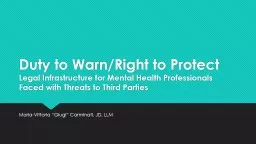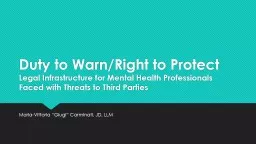PPT-Duty to Warn/Right to Protect
Author : test | Published Date : 2018-10-08
Legal Infrastructure for Mental Health Professionals Faced with Threats to Third Parties MariaVittoria Giugi Carminati JD LLM General Overview of Duty to Rescue
Presentation Embed Code
Download Presentation
Download Presentation The PPT/PDF document "Duty to Warn/Right to Protect" is the property of its rightful owner. Permission is granted to download and print the materials on this website for personal, non-commercial use only, and to display it on your personal computer provided you do not modify the materials and that you retain all copyright notices contained in the materials. By downloading content from our website, you accept the terms of this agreement.
Duty to Warn/Right to Protect: Transcript
Download Rules Of Document
"Duty to Warn/Right to Protect"The content belongs to its owner. You may download and print it for personal use, without modification, and keep all copyright notices. By downloading, you agree to these terms.
Related Documents














![[PDF READ ONLINE] Starting Off Right in Law School (Starting Off Right Series)](https://thumbs.docslides.com/1020243/pdf-read-online-starting-off-right-in-law-school-starting-off-right-series.jpg)